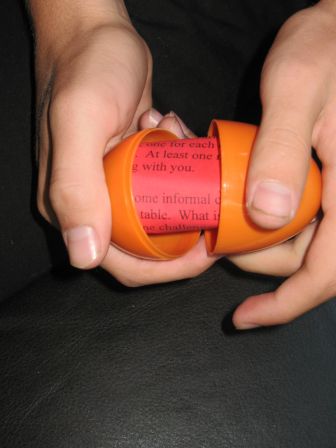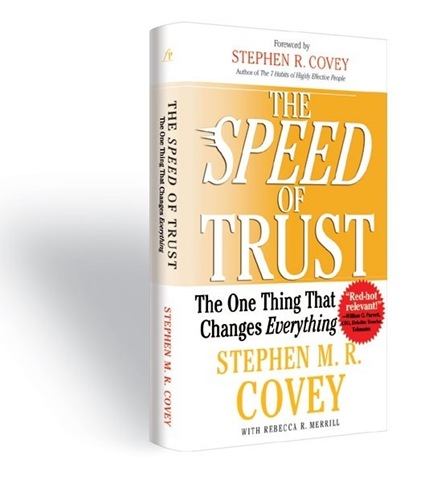


August 2010
Feedback From Readers: Thoughts about Trust
In this Issue:
|
Say
It Quick |
Discoveries bits of serendipity to inspire and motivate |
Ideas fuel for your own continuous learning |
Activities tips and tricks you can try today |
| The Cover Up | Carpenter Bees | The Risk of Full Coverage | Learn by Dis-Covering |
What does an insidious insect have to do with curiosity, discovery, and the secret lives of learners? That's a hint at the direction we're heading this month beginning with this 99-Word Story about integrity.
The Cover
Up
At the grocery superstore with its polished aisles and fully stocked shelves,
you can find delicious looking cinnamon rolls made right there. They smell
like grandma's and they're slathered with a thick layer of frosting. But the
bread-like substance underneath resembles a woolen mitten. The baker uses
so much sugar above you don't realize the below is second class.
Rather than "sugar coating" a problem, focus on quality to begin with. And, if you're going to spend the money, and store the calories around your middle, you might at least get something that tastes first rate!
 Carpenter
Bees
Carpenter
Bees
They are big, slow, and not particularly dangerous - unless they threaten
your home. I'd never heard of carpenter bees until this spring when I began
seeing fresh sawdust on the ground outside my home. These critters drill a
perfectly round hole into the siding of the house about an inch deep. Then
they take a right angle and keep drilling for as much as two feet. There they
lay eggs and begin another lifecycle that can result in the return of adults
to the same hole next year.
How do you deal with them? Spraying gets them if they are on the wing. But once inside their holes the spray is useless. If you cover over the hole, the larvae, once mature, will simply drill another exit. Instead, you have to inject a special pesticide and plug the hole with a soft cork. Then, when the bees leave their hole, they will crawl through the poison and meet their demise as they push the cork out of their way.
Carpenter bees can return year after year. And their busy hole drilling work attracts even more bees to a vulnerable home. The maddening thing is not knowing what's going on inside, below the surface, deep within the woodwork. Did I find all the holes? Have I used enough poison? Is my home still attractive to boring bees? And does it matter that the siding looks like Swiss cheese? Maybe I should just cover over the whole house with vinyl siding. It would be costly but at least I'd be in control, right?
The Risk of
Full Coverage
I 'm guessing (and hoping) that a relatively small number of readers this
month will ever need to worry about an attack of carpenter bees. But the activities
of these troublesome insects provide an interesting analogy for some of the
work we do as leaders, educators, and trainers.
Early in my career, I once began a workshop saying, "We won't be taking a break during the next three hours because we have so much to cover." I can't believe I said that as a training facilitator. Fortunately, it was more than 20 years ago and I've learned a lot since then.
Often we talk about the need to "cover" a subject. There is so much important material that we think we need to control what people are learning. But in the process of "covering the material" we end up "covering over" the learning going on inside our participants. If we cover over a carpenter bee's hole, we'd never know whether the bees hatched and crawled through the poison or not. We'd have no clue about what was happening inside.
Similarly, when we cover a topic in training, we are so busy patching holes in the knowledge base of participants that we don't take time to consider what's really going on inside their heads. Have we provided an opportunity for people to compare and contrast our new information with their previous experience? Have we encouraged them to make connections with similar processes or systems? And have we challenged learners to apply the new information to their work or personal life?
Yes, provide information. But keep it interesting and relevant allowing time and space for reflection and interpretation.
Whether we are leading, teaching, training, or mentoring, if we cover a topic with a sugary veneer of information, people are less likely to drill down to the substantive issues that will make a lasting, reoccurring impact on their work and their lives.
 Learn
by Dis-Covering
Learn
by Dis-Covering
One alternative to "covering" a topic is letting participants "dis-cover"
the information by themselves. Here is an activity that you can easily adapt
the next time you have information or knowledge you want to share. It was
inspired by my daughter, Tilden, who had to make a presentation to her class
contrasting the basic information about two major world religions.
Break the factual information of your topic into small chunks of a few sentences or very short paragraphs. Number them, if a specific order is important, then print them and cut them apart. Next, fold each piece of paper and put it inside a hollow plastic egg and hide all the eggs in the vicinity of your training or meeting.
When people are assembled and it's time to present your information, send people on a treasure hunt to find the eggs. Have people take turns reading the information they find inside their eggs. You can supplement what people share with additional information or intersperse discussion questions with the facts as people read them.
 As
an alternative, use a color coding system for the information inside the eggs.
For example, all statistics are encased in red eggs. All blue eggs have historical
information, and so forth. When the eggs have been found, give all the red
and blue eggs to different small groups and ask them to consolidate their
information and make a presentation to the whole group.
As
an alternative, use a color coding system for the information inside the eggs.
For example, all statistics are encased in red eggs. All blue eggs have historical
information, and so forth. When the eggs have been found, give all the red
and blue eggs to different small groups and ask them to consolidate their
information and make a presentation to the whole group.
Stretch this activity by challenging people to think of the whole process as a metaphor. How is hunting for information like continuous learning in your organization? Where is information hidden in the workplace? What surprises are revealed when we intentionally look for new ideas in unusual places? Who, or what, is hiding helpful insights from view in our daily work? What opportunities do we have for our own collaboration in discovering new on-the-job learning?
If using eggs seems childlike, try colored envelopes or small gift boxes. Whatever you use, combine elements of discovery, surprise, and anticipation along with small, digestible chunks of information. The point is to reach a deeper level of understanding and learning. And when you achieve that objective, please, and tell me what happened!
Trust
The Firefly News Flash for May 2010 featured
a review of Steven M.R. Covey's book
The Speed of Trust. It elicited thoughts from several readers...
"I can see loss of trust and its impact on my professional life. Its impact/loss/gains are immeasurable. On a personal note, I lost the trust of colleagues and really never understood what I had done. Whatever I did, it must have been perceived as "nasty." My well-intentioned actions must have been misinterpreted. I reached out and tried to fix a wrong that I was unaware of but the reach out was disregarded and no more discussion was to be hadů relationships broken and I was devastated (still to this day not knowing what I did). Over the span of the following 6 months, something must have happened and that person presented me with a peace offering that I accepted. While still in the dark over what transpired, and even though a peace offering was made, our relationship has never been the same.
"My lesson: While I tried to reach out to try to understand, the circumstances were so devastating for the other person that the strong relationship that had been established was not even strong enough to give me the benefit of the doubt and to allow me an explanation. Establishing and maintaining trust is a hard thing to do. What has helped me going forward is to express my personal values up front; stating my beliefs and expectations for most of my professional relationships. Also I have learned to focus on the future and let bygones be bygones. We can only control our thoughts and actions. I also learned that accepting blame (even if it wasn't my intention to hurt) allows others to regain trust.
"Another story: Last winter I was working on a very stressful project with a client that had come to trust me. Client internal issues, tight deadlines, and miscommunication, caused a bad reaction to my work. Even though the documents were in draft form and far from final, the client was "disappointed." I apologized, took responsibility, fixed it, and cooperated. Not knowing how the future would look with this client, they contacted me saying that they appreciated my apology and willingness to work with them. (They also acknowledged the bad process and lack of experience on the part of the project manager.) Now I am working with them again, regaining trust on an even higher level.
"TRUST is so powerful; it can rise us up and destroy relationships over night! As a result, my current work is deeply rooted in helping others establish and maintain trust in the workplace and dealing with whatever consequences occur with a focus on future actions."
-- Sonia Di Maulo
At a recent class on communication given by Gina Maddox, I made a note of how many times trust must be capitalized upon before it is fully restored. After trust is violated, Ms. Maddox stated it took approximately 12 times with trust being extended and followed through before trust can be fully restored in a relationship. I forgot to ask her where she got this information. I find it especially intriguing and was wondering I you have heard a similar metric for trust restoration in relationships?
--Eric Palmer
Answer from Brian:
Eric,
It would be interesting to know the source of Gina's 12 times to restore trust. I have not heard of any specific number. I think the idea of a metric for restoration of trust is an interesting concept. Wouldn't it be wonderful to know that after I'd done x number of trustworthy things I wouldn't have to worry about my relationship with that person any longer!I think there are several issues involved:
Severity of broken trust as perceived by the "victim." Was this a broken agreement for a $2,000,000 deal or canceling a lunch date? Depending on the person offended, a lunch date could be worth more than any amount of money! Alternatively, does a Bill Gates care about $2,000,000?Interpersonal temperament. Some people are more sensitive, take things personally, are less secure, assume the world is against them, etc.
Personal needs. Some people stay in untrustworthy relationships, allowing far fewer than 12 trustworthy acts to restore the relationship, in order to fulfill their own needs. (I'm thinking of people who stay in abusive relationships.)
From my observations, it only takes one "slip" to shake another person's level of confidence and trust in you. Such a slip could be unintentional on your part but have been misinterpreted by the other person. So, it makes sense to always be doing things to build trust. Then, when something goes awry, your misstep is either not perceived as a trust violation or it is quickly forgiven.
Eric:
I would welcome any other responses to the question. I definitely agree with multiple other factors feeding into the level of violation or tolerance. One thing I believe is often missed which relates to trust is culture and how various cultures interpret various attempts at building trust or violations of trust.
(Please accept Eric's invitation to share your thoughts by an email!)
Read previous
issues. Click Archives!
To add or delete your name to our mailing list, email
with a short note in the subject line.
I want this newsletter to be practical, succinct, and thoughtful. If you have suggestions about how we can meet these criteria, please let us know! Send us an with your thoughts and ideas.
Home
| Services | Products
| Mission | Ideas
| The Group | The
Buzz
(c) 2005 - 2010 The Firefly Group